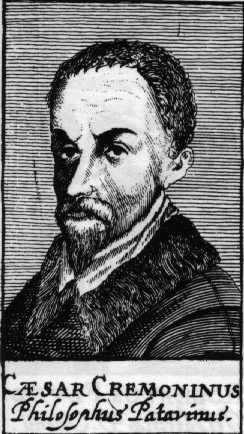<Back to Index>
- Philosopher Cesare Cremonini, 1550
- Sculptor Luca della Robbia, 1400
- King of Sicily Roger II, 1095
PAGE SPONSOR

Cesare Cremonini, sometimes Cesare Cremonino (22 December 1550 – 19 July 1631), was an Italian professor of natural philosophy, working rationalism (against revelation) and Aristotelian materialism (against the dualist immortality of the soul) inside scholasticism. He signed his Latin texts Cæsar Cremoninus (and its genitive form Cæsaris Cremonini at the start of some titles), or Cæsar Cremonius.
Considered one of the greatest philosophers in his time, patronized by Alfonso II d'Este, Duke of Ferrara, corresponding with kings and princes who had his portrait, paid twice the salary of Galileo Galilei, he is now more remembered as an infamous side actor of the Galileo affair, being one of the two scholars who refused to look through Galileo's telescope. Galileo used him as the main prototype for the character Simplicio in his Dialogue Concerning the Two Chief World Systems. Cesare Cremonini was born in Cento in the then Papal States. He was a professor of natural philosophy for about 60 years: He taught the doctrines of Aristotle, especially as interpreted by Alexander of Aphrodisias and Averroes. He was so popular in his time that most kings and princes had his portrait and corresponded with him, sometimes consulting him about private and public affairs. At
Padua, his salary was twice that of Galileo. He was especially popular
among the French intellectuals who called him "le Cremonin" (the
Cremonin); even a remote writer such as Jean - Louis Guez de Balzac mentioned him as "le grand Cremonin" (the great Cremonin) in his Lettres.
At Padua, Cremonini was both a rival and a friend of his colleague Galileo (who taught
geometry, mechanics, and astronomy there from 1592 to 1610). When
Galileo claimed he had discovered mountains on the Moon, Cremonini was
one of the scholars who sternly refused to even check through the
telescope, alleging that Aristotle had definitely proved that the Moon
could only be a perfect sphere. Later, Galileo used Cremonini as the
main prototype for the character Simplicio in his Dialogue Concerning the Two Chief World Systems. But when Galileo was about to move, Cremonini warned him that moving from Venice ruled Padua to Tuscany would bring him under the jurisdiction of the Roman Inquisition. Following up on the controversy opened in 1516 by Pietro Pomponazzi and continued by Jacopo Zabarella (his
predecessors in the chair), Cremonini too taught that reason alone
cannot demonstrate the immortality of the soul - his blind adherence to
Aristotle implying that he believed in the mortality of the soul. After
a paper he wrote about the Jesuits, and public statements he made in
favor of laic teachers, the Jesuits in Venice accused him of materialism, then relayed their grievances to Rome. He was prosecuted by the Inquisition for atheism and the Averroist heresy of "double truth",
and ordered to refute his claims: as was his manner, Cremonini gently
refused to retract himself, sheltering himself behind Aristotle's
authority, and because Padua was then under the tolerant Venetian rule,
he was kept out of reach of a full trial. (In 1611, the Inquisition would check their proceedings against Cremonini in search of ammunition against his friend Galileo.) As for the accusations, and beyond Cremonini's teachings: indeed his personal motto was "Intus ut libet, foris ut moris est" (Latin for "In private think what you wish, in public behave as is the custom"), which was taken by humanists as meaning that a scientific thinker could hold one set of opinions as a philosopher, and another set as a Christian; it was also adopted by European Libertines (brought back to France by his student and confidant Gabriel Naudé).
After his death, Cremonini had his tombstone engraved with "Cæsar
Cremoninus hic totus jacet" (Latin for "Here lies all of Cremonini"),
implying that no soul survived. His student Naudé (who had been his confidant for three months) qualified most of his Italian teachers as "Atheists" and
especially Cremonini as a "déniaisé" ("one who has been
wised up, unfoolish, devirginized", the Libertines' word for
unbelievers); he added to his friends, translated, "The Cremonin,
Professor of Philosophy in Padua, confessed to a few choice Friends of
his that he believed neither in God, nor in Devil, nor in the immortality of the soul: yet he was careful that his manservant was a good Catholic, for fear he said, should he believe in nothing, that he may one morning cut my throat in my bed". Later, Pierre Bayle pointed out that Cremonini did not believe in the immortality of the soul (in the "Crémonin" article of his Historical and Critical Dictionary). Gottfried Leibniz, in his 1710 Theodicy, dealing with the Averroists, who "declared that man's soul is,
according to philosophy, mortal, while they protested their
acquiescence in Christian theology, which declares the soul's
immortality", says "that very sect of the Averroists survived as a
school. It is thought that Caesar Cremoninus, a philosopher famous in
his time, was one of its mainstays". Pierre Larousse, in his opinionated Grand dictionnaire universel du XIXe siècle, stated Cremonini was not a Christian. When he died in 1631 (during the Paduan outbreak of the Italian Plague of 1629 - 1631), more than 400 students were working with him. His previous students included, alphabetically: He was buried in the Benedictine monastery of St. Justina of Padua (to
which he also willed his possessions). His name has been given to
several streets ("via Cesare Cremonini" in Cento, "via Cesare
Cremonino" in Padua) and an institute ("Istituto Magistrale Cesare Cremonini" in Cento).